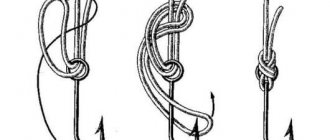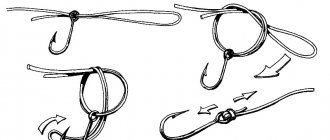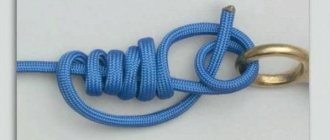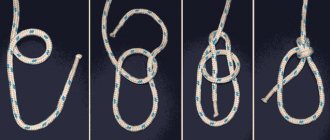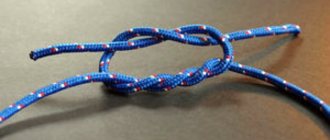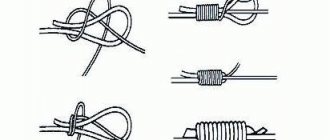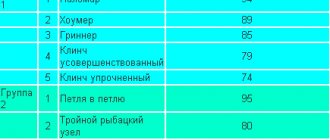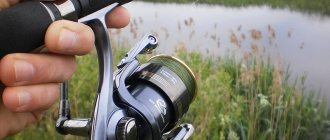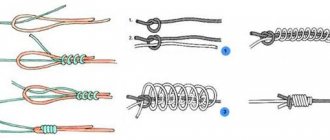Many fishermen are interested in the question of how to knit a figure eight knot (by the way, it has several names, the most common of which is the flagship knot). The knot has become very popular because tying it correctly is quite simple
and it
can withstand heavy loads
.
And the versatility can be envied by other knots ( a figure eight is used to tie fishing line to fishing line, leashes and even hooks
).
Simple, durable and reliable
- this is how you can characterize the figure eight knot for fishing. Even with a very heavy load on the line, it will be quite difficult to untie it.
Another excellent feature of such a knot is that when tightened, the fishing line is not damaged or deformed.
, it is thanks to this that the original strength can be preserved and the place of the ligament is unlikely to become the weakest part of the equipment.
But that’s not all; it won’t be difficult to untie such a knot with your hands. Some fishermen even use it as a stop knot for a sliding float, only it is tied not on a regular fishing line, but on a cord, but this is a slightly different question.
Knitting pattern
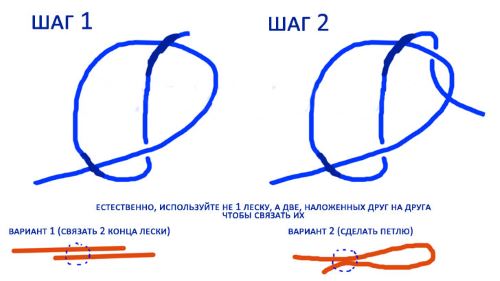
There are a lot of ways to knit a figure eight knot, it can be a double or counter figure eight, and a conductor. But that's not what we're going to talk about now. Let us present to your attention a knitting pattern for the correct, classic knot, which is used by climbers and fishermen.
Let's look at the step-by-step instructions (the diagram of which is provided in the figure above). And then let’s move on to the video, after watching which even a beginner will learn how to tie a knot:
- The very first thing to do is fold the end of the fishing line in half. So that it forms a kind of small loop.
- Now place the upper tip of the resulting loop on its base. And pass it under the loop.
- Now pull this tip into the loop.
- That's it, you have tied a figure eight on the fishing line.
Yes, I didn’t describe it very well, but I can’t do it any other way. Better watch the video and pay attention to the picture above. This is the simplest, basic version of the node. There are also a bunch of other gadgets for it and ways to install equipment using them. But first things first.
I almost forgot to say. Fluorocarbon fishing lines are not tied with such a knot. It is absolutely not suitable for them. So keep that in mind.
Nodes: application features
In addition to the cases listed above, there are many more situations in which knitting skills can be useful. People don’t even think twice about using one pattern or another (laces, tie, belt, bow, scarf). In each situation, the node carries a different load and is used for different purposes.
For example, you can tie the ends of a rope for fastening on a children's sled in different ways. A blind loop or a figure-of-eight knot at the end of a segment previously threaded into an eyelet or hole on the frame will work here. When choosing one option or another, compliance with knitting patterns and rules is often not taken into account. People simply use the first suitable combination of interlacing ends, as long as they form what they think is a reliable knot.
Meanwhile, the wrong choice can play a decisive role at a crucial moment. All knots weaken the overall strength of the rope or cable to some extent. But some of them have a smooth increase in breaking force when tightened, which is very important. At the same time, using one scheme, you can expect easy and quick untying of the knot even under heavy load, but using another, this is not possible.
Video instruction
Video is a great way to convey any information to a person. Spend a minute of your time watching the video and you will remember for the rest of your life how to tie such a knot. Take the rope in your hands, watch the video and repeat after the presenter. And then you will be surprised how easy it is to do it.
And the time to tie a knot will be only a few seconds. You should definitely pay attention to how the ends of the fishing line fold
. Otherwise, such a knot will not be suitable for fishing, because it will turn out to be quite bulky and will weaken.
https://youtu.be/gMk6DomvbMM
Having trouble catching a lot of fish? Do your friends constantly catch more than you? Then you definitely need a bite activator
with which it becomes possible to catch many times more fish. People buy it and it works. The main thing is to apply it correctly.
Useful tips
- Master the basic pattern first, after which variations will become much easier.
- You can tighten the knot on most types of fishing line, but there is one difference from many other popular knots: the figure-of-eight knot is very easy to untie, but you need to pay attention to the strength on thin fishing lines.
- Variation variations are different. The fishing "eight" is stronger than the Canadian one, use more reliable options.
- If you want to increase strength, fold the running end twice before creating a figure eight.
- In order to make the knot more reliable, thread the running end into the loop a few times and only then tighten it.
- Try to tie the knot evenly, without overlapping the fishing line in the knot, then the strength and reliability will increase.
Advantages and disadvantages
All fishing knots are different and each has certain pros and cons. Eight is no exception to this. It has a number of advantages, but it is not without its disadvantages. Although, some fishermen do not consider them cardinal at all.
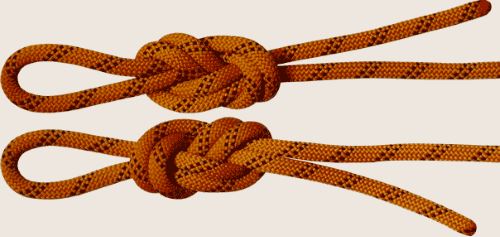
Advantages
- It is very easy to knit
. - Wide range of uses
. The figure eight can be used to tie line to line, mount a leash, secure a hook, or simply tie two ropes together. - The node does not move
. When tightened and used, it remains motionless and is located strictly at the point at which it was tied. This is precisely why many people make a stop knot with it, and also tie it at the end of a fishing line or rope. - The knot is very easy to untie yourself
. It does not tighten tightly under heavy loads and it is quite easy to untie the figure eight back. - Doesn't weaken
. This installation will not weaken the fishing line or rope, so it is often used to tie two ends of the fishing line.
Flaws
- You can only tie it on a thick fishing line
. Knitting leashes using such a knot is unlikely to work, but attaching them to the main fishing line is quite simple. - You will have to fold the running end
. This point occurs when installing on thin fishing lines; to increase the strength of the connection, you have to fold the running end of the rope in half, and only then tie a knot. - definitely need to know the variations
. - Loses strength
. The strength of the unit decreases sharply when mounted on hard materials; for example, as mentioned above, it cannot be mounted on fluorocarbon fishing line.
Pros and cons of eights
The mating options discussed here are the most famous, and have been since ancient times. Since then, many more variations based on the figure eight have been developed by inventive people, especially fishermen. But their pros and cons remain.
The main advantages of eights:
- the scheme of an ordinary eight is accessible even to a novice fisherman;
- external pressure does not lead to displacement of the node;
- The loop is not pulled so tightly that it takes a long time to untangle.
The main disadvantages of eights:
- These knots are by no means used for fishing lines with a thin diameter; they provide the greatest strength on thick cords and ropes, and fluorocarbon generally loses half of its strength from such a bundle;
- if, nevertheless, a fishing line of small diameter is used, then several ends have to be folded, which increases the time of knitting a knot;
- When folding the running end, the joint strength doubles by a quarter.
This is interesting: Fire safety in forests: requirements, violations, responsibility
Double figure eight knot
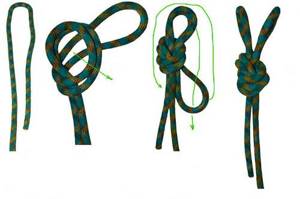
This type of assembly is usually used to complement other fastening elements; some use it to insure the regular and counter figure eight. The main difference between this knot and the previous one is that at the end of the fishing line two loops are formed, instead of one
. Let's tell you in more detail how to properly tie a double figure eight knot.
- Now, just like for a regular figure eight, you need to attach the tip of the fishing line to its base.
- Now wrap the resulting loop around the main fishing line, as shown in the diagram above.
- Then pull the tip into the loop, but not all the way. Stretch only halfway so that equal parts are on opposite sides of the loop.
- Now each loop (there should be two of them) needs to be pulled into the adjacent loop.
- Almost ready, all that remains is to tighten the knot.
At first glance, the procedure is quite complicated, but after doing it several times and understanding how to knit a figure eight knot, you will not notice any particular difficulties. After a few seconds, you can easily and simply get a knot, at the end of which two loops (non-tightening loops) are formed.
Non-standard eights
The directional figure eight is one of the interesting types of these nodes. It is aimed at the fact that the rope squeezing it on the other side works for additional tightening, that is, the fastening is tightened under its own weight or the weight of a suspended load. It is used most often by climbers, and is made as follows:
- a loop is made on the rope;
- the resulting loop lies under the free end of the rope;
- this loop is wrapped around the main rope and lowered into the hole created.
It is important to ensure that the first loop covers the main rope, otherwise the connection will be weak. It also has other disadvantages. It is important for the climber to untie the knot with a jerk when the goal is achieved, but here this will only lead to greater tightening of the entire structure.
Often, distrustful people add extra turns and ties to these connections, but this is unnecessary
Unleashing figure eight. It has been used for a long time by sailors when they need to quickly leave the shore. This is an ordinary fishing eight, only a halyard was inserted into its last loop, holding the ship near the shore. With a sufficiently sharp jerk, the halyard was released, and the ship rushed into the sea. Nevertheless, it has been used from ancient times to the present day.
Canadian eight. Canadians adapted the figure eight fishing knot primarily for tying fishing hooks and quickly releasing them for replacement. It performs well on synthetic fishing lines, where it is not so easy to remove the hook from other knots. There is always a bait at the end of the tackle, which may not work when encountered with a large fish. This is where the Canadian eight comes to the rescue. It fits like this:
- a fishing line is threaded through the eye of a fishing hook;
- then one turn of the fishing line is made around the fore-end, and during the turn the line should pass closer to the fore-end, that is, under the loop;
- further down in the direction of the fore-end, another loop is threaded, and the knot is tightened.
The main advantage of this simple tying method is the quick change of hooks when using nylon fishing line.
Node improvements
People tend to experiment, and tying knots is no exception. Why not figure out how to tie a figure eight knot for purposes other than connecting the fishing line, the fishermen thought. And we decided to adapt it for other, no less useful purposes:
- A figure eight knot above the ring
is used by fishermen to tie a hook. The end of the fishing line is pulled through the ring on the hook, thereby forming a blind loop, after which it is cut off. - Fisherman's eight
- also used for tying a hook, but the knot is not located above the ring, but below it, covering the fore-end. The end of the fishing line is threaded into the eye of the hook, then 5-6 turns are made on the shank, and then pulled back into the ring. Then knit a figure eight on top of the hook. - The Canadian figure eight fisherman's knot
is also used for mounting a hook, but is only tied on the fore-end. - A knot for tying a hook with a spatula
instead of a ring. It is knitted in exactly the same way, only instead of the eye of the hook, a regular knot is used at the running end.
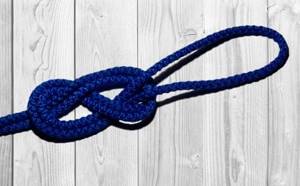
Figure eight knot: how to knit, diagram
Another name is “Flemish loop”. The main purpose and simplest application is the formation of a thickening (stopper) at the end of a piece of cord, rope, fishing line, cable, rope. Advantages: it weakens the overall strength a little, knits quickly and easily, looks good. If the material is sufficiently strong, the figure-eight knot is relatively easy to untangle if necessary, even under severe tightening stress.
To tie it, you need to wrap the free end (its length is chosen experimentally) of the forward-directed cord in the opposite direction, pass the end under the main segment, and then pull it into its formed loop. The way people work may differ. Someone forms a loop with the free end drawn over the main segment, the other - from below. In the grand scheme of things, it doesn't matter. The main thing is that the end goes through the loop.
However, you need to wind it not as in the case of simply tightening it along the shortest path (there are only two options), but by passing the cord over the resulting ring. When you try to tighten it, something like a figure eight should form.

Tips for tying
Now the most interesting thing is that we analyzed the most common mistakes that beginners and experienced fishermen make. And now we are ready to provide you with a number of tips on how to knit a figure eight knot so that it turns out to be as strong and correct as possible:
- Under no circumstances should the fishing line be deformed or the turns overlap each other. Be sure to make sure that the turns lie side by side and do not overlap, and only then tighten the knot;
- If you doubt the correctness and reliability of installation, it can be treated with waterproof glue;
- Often fishermen tie a metal leash with such a knot when fishing with a spinning rod. If it turns out that the end of the knot sticks out to the side, then simply press it to the main fishing line and treat it with nail polish;
- Be sure to check the knot for strength at home before going out to the pond;
- To prevent the fishing line from deforming, you need to wet the knot before tightening (this applies not only to this type of knot, but to all);
I hope you have received enough information on how to tie a figure eight knot and tell us about it in the comments. Well, for those who do not fully understand, I recommend consolidating the knowledge gained by watching a video about step-by-step knitting a knot.
Locking knots
In most cases, an incorrectly tied shoelace does not have serious consequences. But weakening the safety net in rock climbing or mountaineering is a serious violation of safety regulations. When it is necessary to tie two very thick ropes or pieces of rigid car cable (a thin guitar string), there is no way to tighten the knot tightly. In this case, the usual schemes will not work - a special approach is required.
In maritime practice, there are more than 500 types of various types of connections of ropes, cables, ropes. The figure-eight locking knot occupies an important place among them. It is easily recognizable, relatively simple to implement, and serves as the basis for many other, more complex schemes.
To confidently consolidate the skills of knitting, as experts say, only five to six repetitions during training are enough. As a result, another combination will appear in your arsenal, which can be used, if necessary, both to connect thick threads and to form a knot on a torn dog leash.

